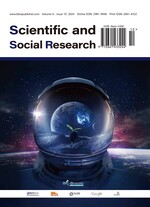Abstract
With the development and application of digital twin technology, the problem of privacy leakage is becoming increasingly prominent. Privacy leakage issues caused by data abuse and weak awareness have attracted high attention. In this regard, this paper analyzes the causes of privacy leakage in the digital twin, analyzes the difficulties of privacy protection under the background of the digital twin, and puts forward the “legal co-governance model.” Through multi-party cooperation, improving the system, and improving literacy, people can effectively protect private information, ensure the security application of technology, law, and ethics, and provide a guarantee for the sustainable development and social application of digital twin technology.
References
Yi JL, 2021, Law and Accountability in the Digital Twins Era —— Through the Technical Standard Perspective Algorithm Black Box. Oriental Law, 2021(4): 77–92. https://doi.org/10.3969/j.issn.1007-1466.2021.04.007
Diao SF, Kong XY, 2022, Ethical Issues on the Application of Digital Twin Technologies in the Educational Field. Journal of South China University of Technology (Social Science Edition), 24(06): 16–24. https://doi.org/10.19366/j.cnki.1009-055X. 2022.06. 003
Beduschi A, 2019, Digital Identity: Contemporary Challenges for Data Protection, Privacy and non-discrimination Rights. Big Data Society, 6(2): 205395171985509.
Shi ZY, Jin C, 2024, The Institutionalization of Digital Ecological Civilization: The Implication of the Time, the Development Dilemma and the Game-breaking Strategy. Journal of China University of Geosciences (Social Science Edition), 24(2): 117–130. https://doi.org/10.16493/j.cnki.42-1627/c.20240015.001
Threat Hunter, 2024, 2023 Data Breach Risk Annual Report, https://www.threathunter.cn/blog/2023-30a8268f-be39-4e6e-91cb-2e5b97a4780f
Meng FZ, 2023, Strengthen Co-governance, Standardize the Application and Development of Algorithms. The China Press Industry, 2023(09): 5. https://doi.org/10.13854/j.cnki.cni.2023.09.109
Zhai JG, Zhang XL, 2020, Application Guidelines and Typical Case Analysis of the Civil Code of the Peoples Republic of China. China Democracy and Legal System Publishing House, Beijing.
Zhao D, Shen C, 2023, Investigation and Reflection of the Judicial Review Elements of Data Capture and Unfair Competition Disputes. Technology and Law (Chinese and English), 2023(2): 52–59.
Yuan K, Zhang SH, Ma SS, et al., 2021, The “Right Book” to Guarantee Security is still the “Arbitrary Door” to Steal Information. Guangming Daily, August 19, 2021, 7. https://doi.org/10.28273/n.cnki.ngmrb.2021.004263
Cai BK, Xu XL, 2023, Legal Regulation Analysis of Data Security in the Application of Artificial Intelligence. Technology Think Tank, 2023(07): 45–52. https://doi.org/10.19881/j.cnki.1006-3676.2023.07.07
Xu RP, Liu J, 2022, Algorithmic Risk and Ethical Governance in the Digital Twins Era. Journal of Foshan University of Science and Technology (Social Science Edition), 40(04): 31–39. https://doi.org/10.13797/j.cnki.jfosu.1008-018x.2022.0037
Zhang M, Zhang N, 2022, The Legal Dilemma and the Perfect Path of the Intelligent Pension. Journal of Yuncheng College, 40(02): 53–60. https://doi.org/10.15967/j.cnki.cn14-1316/g4.2022.02.004
Yan Q, 2022, Digital Twins: Risk, Traceability, and Regulation. The National Library Academic Journal, 31(05): 104–112. https://doi.org/10.13666/j.cnki.jnlc.2022.0511
Li HR, Wang ZB, 2021, Research on Personal Information Protection of Government App under the Background of Reform of “Decentralization, Administration and Service”. Information Network Security, 2021(S1): 45–49.
Wang LP, 2022, Privacy Regulation in the Context of Artificial Intelligence. Network Security Technology and Application, 2022(08): 124–126.
